
Army BMI Calculator – The Complete Clinical Guide Based on Global Military Standards
Body Mass Index (BMI) is a universally recognized clinical measurement that evaluates body weight status relative to height and acts as an indirect surrogate marker of health risk, adiposity level, obesity risk, metabolic disease probability, and physical readiness capability potential.
Within global defense medical regulatory frameworks, BMI is used as one of the standardized screening metrics to determine initial recruit eligibility, continuation of service physical readiness compliance, medical review necessity, and body composition assessment escalation indication.
What Is the Army BMI Calculator?
The Army BMI Calculator allows accurate computation of BMI using the standard medical formula, and in a military context it is used as the baseline quantitative index before advanced body fat protocols, circumference assessments, or strength & endurance qualification stages are initiated.
Why BMI Matters in the Army?
Every nation’s army applies BMI within slightly different regulatory standards, although the formula mathematically remains the same internationally. What differs are the BMI cut-off ranges, acceptance windows, waiver eligibility thresholds, fat composition tolerance, height-weight screening tables, and final physical performance qualifying limits. The military population is not the general civilian population. Therefore, armies worldwide treat BMI not merely as a weight classification but as a combined determinant of health readiness. Excessive weight, low muscle mass, obesity, excessive lean loss, sarcopenia pattern weight, and non-functional hypertrophy are all medically disqualifying risk conditions that BMI flags.
BMI Formula (Primary Standard Medical Method)
BMI is calculated through the universally accepted medical formula below:
Metric Formula
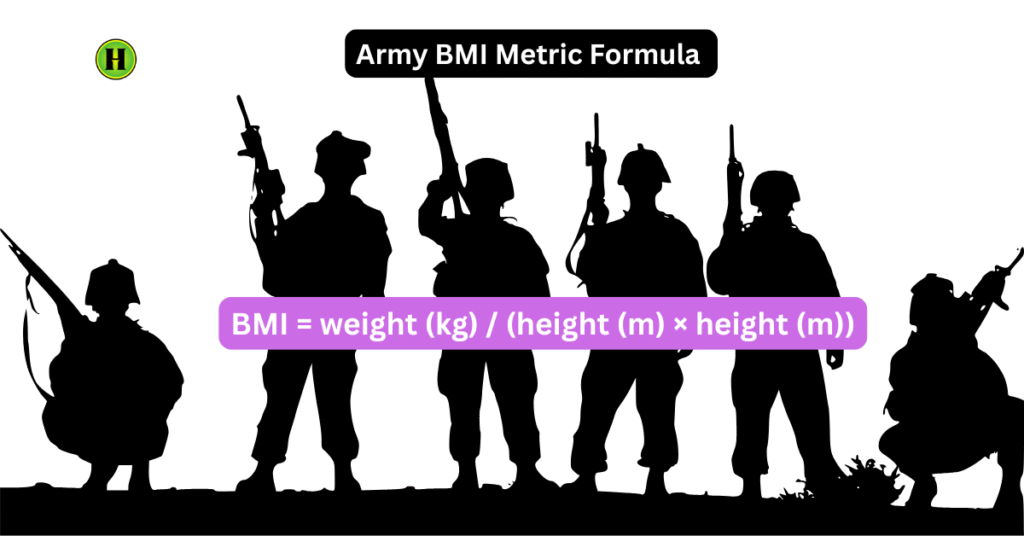
Imperial Formula
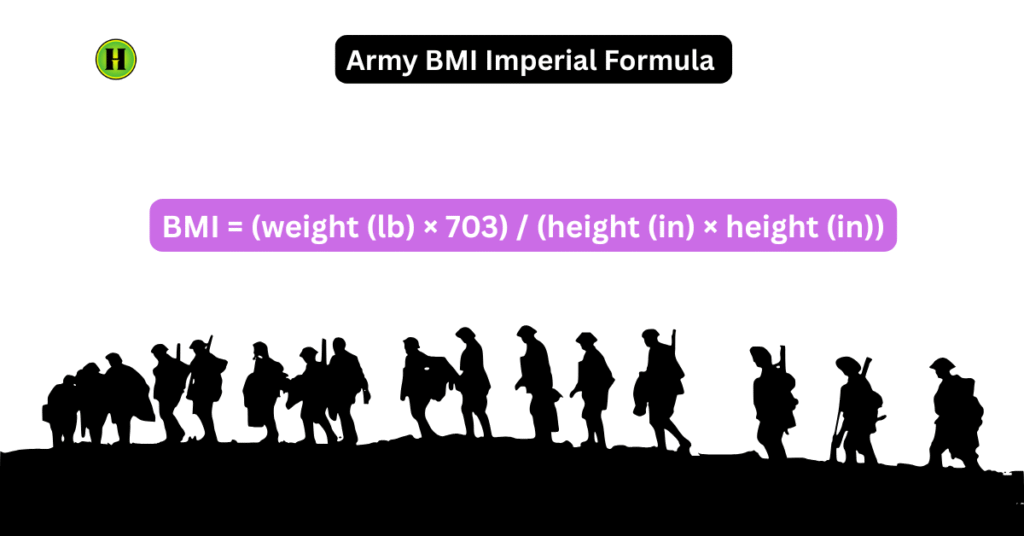
This is the formula armies worldwide officially base their primary screening from. BMI is always computed before body fat % protocols. If a soldier or candidate fails BMI thresholds, then circumference body fat determination is triggered.
Army BMI Formula (Standard Calculation)
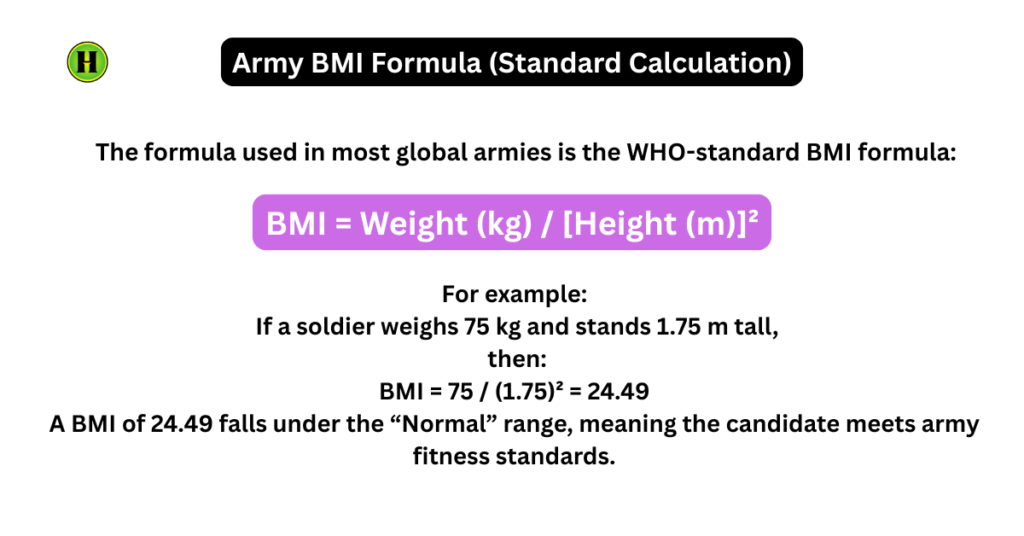
Army BMI Classification Chart
| BMI Range | Category | Army Status |
|---|---|---|
| Below 18.5 | Underweight | May need weight gain plan |
| 18.5 – 24.9 | Normal | Fit for service |
| 25.0 – 29.9 | Overweight | Borderline – requires review |
| 30.0 and above | Obese | Disqualified or requires fat test |
Different armies, however, may have country-specific BMI variations.
Army BMI Standards by Country
US Army BMI Standards
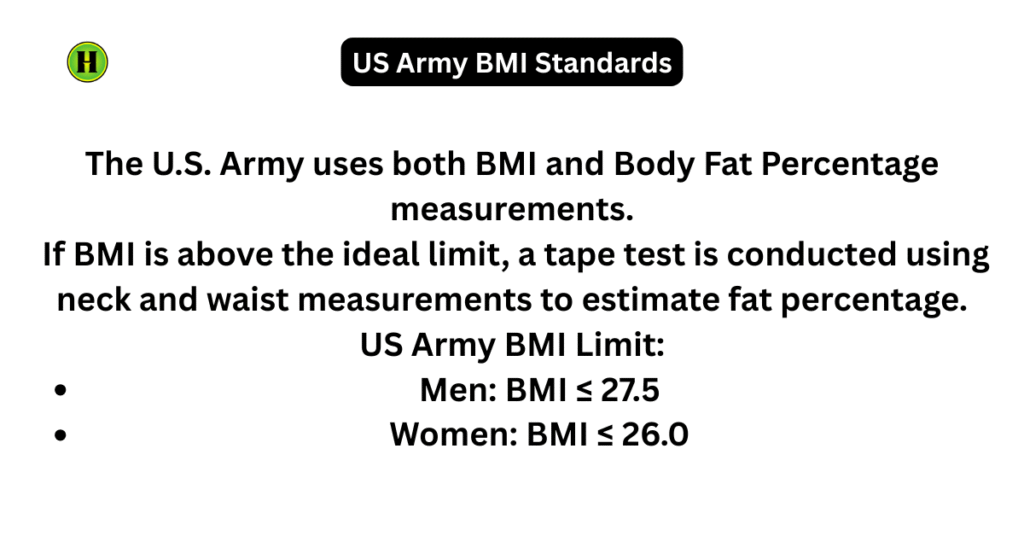
Indian Army BMI Standards

British Army BMI Standards
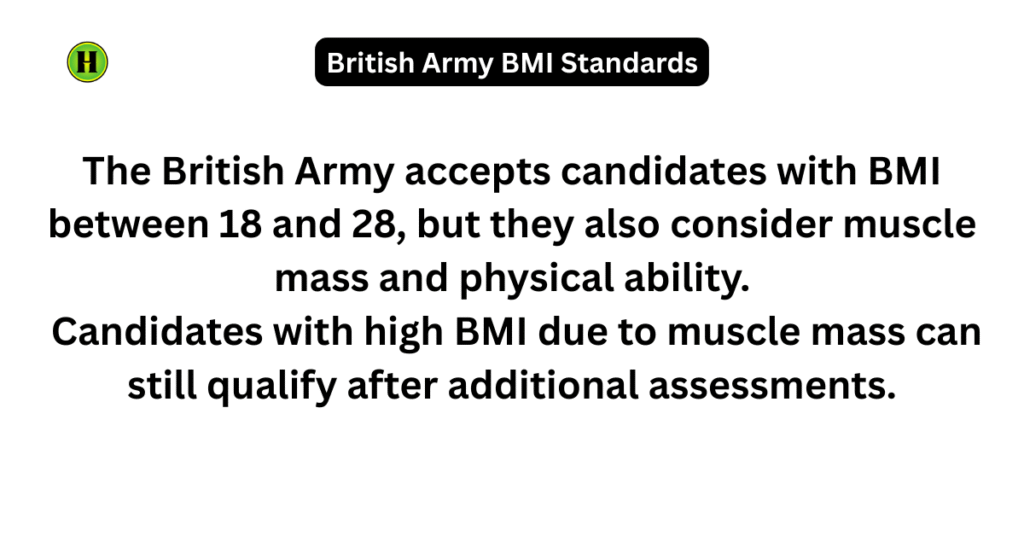
Army BMI vs Civilian BMI
| Aspect | Army BMI | Normal BMI |
|---|---|---|
| Purpose | Evaluate combat fitness | General health check |
| Formula | Same as standard BMI | Standard BMI |
| Additional Tests | Tape test, body fat, endurance | None |
| Acceptable Range | Narrower, stricter | Broader |
| Gender Differences | Accounted separately | Usually unisex |
Army BMI Calculation Method
Let’s break it step-by-step for users:

Army Body Composition (Tape Test) Formula

Army BMI Chart Example (US Standard)
| Height (inches) | Max Weight (Men) | Max Weight (Women) |
|---|---|---|
| 60 | 132 lbs | 120 lbs |
| 65 | 150 lbs | 140 lbs |
| 70 | 170 lbs | 160 lbs |
| 72 | 182 lbs | 170 lbs |
| 75 | 195 lbs | 182 lbs |
Nutrition Strategy for Army Candidates
- Eat whole food dominant diet (lean meats, eggs, lentils, dairy, brown rice, oats, fruits, vegetables)
- Avoid oily / processed street foods and alcohol (especially during cut cycle)
- Sleep minimum 7 hours — sleep loss increases hunger hormones + reduces recovery
Psychological Mindset
Army fitness is consistency based not extreme intensity based.
Small daily improvements beat “weekend hero” training.
Controlling weight is a lifestyle discipline not a temporary exam preparation.
Army BMI Calculator Context Inside Clinical Military Medicine
In military operational medicine and defense human performance science, BMI is not used alone as a final determinant but rather as an initial gateway indicator. This is because military occupational readiness depends on strength-to-weight ratio, body composition balance, endurance tolerance, metabolic health, and musculoskeletal load-bearing capacity under tactical conditions. Soldiers must maintain combat sustainability under stress loads, including ballistic gear, hydration deficit, thermal exposure, sleep deprivation, forced march load, and anaerobic explosive bursts.
Excess adiposity physiologically reduces aerobic VO2 efficiency, increases cardiovascular strain, impairs thermoregulation, and delays tactical speed response time, which, in a war environment, directly reduces survival probability. Conversely, extremely low BMI suggests malnutrition, overcatabolic muscle degradation, weakened neuromuscular function, and susceptibility to stress fractures.
Therefore, Army BMI screening is actually a medical risk stratification model to protect both the army and the soldier from future preventable morbidity and acute mission failures.
Why BMI is Still Used Instead of Only Body Fat Measurement
BMI still remains the first line global screening tool because:
- It is fast
- It requires no equipment
- It is universally standardized
- It correlates strongly with metabolic disease risk
- It is scalable and objective for mass recruit screening
Body Fat % tests are physiologically superior but require circumference measurement, or more advanced methodology like DEXA, MRI, Air displacement plethysmography, Hydrodensitometry etc, which cannot be practically performed for millions of applicants.
So global armies use BMI first, only then move to body fat assessment if BMI is outside the standard.
US Army Body Circumference Body Fat Method (Clinical Summary)
If BMI exceeds screening standards in US Army, body fat content is checked using Department of Defense standardized circumference protocol.
- Male: neck circumference + abdominal circumference
- Female: neck circumference + waist circumference + hip circumference
This is mathematically converted into body fat % comparison against Army maximum allowed % chart threshold.
US Military uses these as final clearance standards, not BMI alone, because muscular increasing mass artificially elevates BMI even if not obese. So circumference method prevents false disqualification.
Marine Corps Standard
US Marines are the strictest body composition military force globally.
Marines consider BMI + body fat + physical performance integration.
If a Marine fails BMI screening AND fails body fat standard, mandatory Body Composition Program enrollment occurs and member must medically correct before continuation.
This has strong scientific justification: combat specialization and amphibious environment demands leaner metabolic performance profile.
Indian Army BMI Screening Clinical Basis
Indian Army uses height-weight screening table primarily, but BMI boundary levels are medically aligned with prevention of future metabolic stress under load.
India also gives special consideration to ethnogenetic South Asian phenotype risk which has higher “metabolically obese normal weight” probability where fat deposition pattern produces cardiometabolic risk even at lower BMI thresholds. Therefore Indian Army screening is extremely health-preservation oriented.
BMI Interpretation (Clinical Global Norms)
General medical interpretation aligned to WHO base spectrum (but armies shift slightly):
- <18.5 Underweight
- 18.5 to 24.9 Normal Range
- 25 to 29.9 Overweight Range
- 30+ Obese
Armies do not allow overweight or obese range without body fat secondary screening pathway approval.
Why BMI Matters for Military Fitness Qualification
For military force readiness:
- BMI predicts long-term injury risk
- BMI predicts cardiovascular disease risk
- BMI correlates to tactical endurance potential
- BMI indirectly correlates to mobility velocity
- BMI correlates to musculoskeletal load tolerance
Higher BMI correlates to increased orthopedic casualty incidence.
Lower BMI correlates to diminished muscle power production.
Therefore, Army BMI Calculator becomes the single most research-backed initial filter tool.
BMI is also used as Legal Regulatory Screening in Defense Medicine
Every nation’s military medical manual contains BMI as mandatory screening. This is not optional. Military medicine has legal consequence structure. If soldier medically collapses due to negligent, avoidable obesity → command is accountable.
So BMI usage is also military law compliance.
Global Army BMI Calculator Screening Approaches (12 Major Forces)
Table shows how screening is done, what happens if BMI/height–weight fails, and what to expect clinically. Exact numeric cut-offs are set by each nation’s current directive; consult the latest official source during processing.
| Country / Force | Primary Screening Approach | Secondary/Confirmatory Method | Practical Notes for Candidates |
|---|---|---|---|
| United States (Army) | BMI or height–weight screening at accession and periodic checks | Standardized circumference body-fat assessment (neck + abdomen for males; neck + waist + hip for females) against age/sex tables | Muscular candidates who exceed BMI often qualify via circumference. Failing both may trigger remedial programs. |
| India (Indian Army) | Height–weight tables mapped to age and role, aligned with BMI reasonableness | Medical board review; fitness testing; in some intakes, body composition/circumference used contextually | South Asian phenotypes can show cardiometabolic risk at lower BMI—panels emphasize holistic medical fitness and endurance. |
| United Kingdom (British Army) | BMI screening with service-set ranges for entry; occupational health review | Body-fat or waist measures; medical and fitness evaluation | Personnel with high lean mass may be individually assessed; ongoing fitness testing is integral. |
| China (PLA Ground Force) | Height–weight/BMI-style screening during conscription | Medical exam; body composition review where indicated | Emphasis on physical fitness battery and overall health; reforms periodically update standards. |
| Russia (Ground Forces) | Height–weight/BMI screening in medical commission | Medical specialist evaluation; fitness verification | Regional commission decisions consider functional capacity and medical history. |
| Israel (IDF) | Height–weight/BMI screening for conscripts | Physician assessment; in some cases body-fat or waist metrics | Combat roles typically require tighter composition and fitness profiles. |
| Japan (JGSDF) | BMI/height–weight screening via Self-Defense Forces medical standards | Follow-up medical evaluation; fitness testing | Conservative medical thresholds, with strong emphasis on endurance. |
| United Arab Emirates (UAE Land Forces) | Height–weight/BMI screening | Physician review; body-composition checks as required | Focus on readiness and heat-stress resilience given environmental conditions. |
| Saudi Arabia (Royal Saudi Land Forces) | BMI/height–weight screening | Medical review and fitness testing; composition checks as needed | Hydration and heat-tolerance counseling are common in conditioning programs. |
| Australia (Australian Army) | BMI screening coupled with medical/fitness evaluations | Follow-up body-composition assessment where indicated | Clear guidance for candidates with high muscle mass; performance tests weigh heavily. |
| Canada (Canadian Army) | BMI/height–weight screening in entry medical | Body-composition verification; ergonomic risk review | Holistic approach balances composition with task-based fitness standards. |
| Pakistan (Pakistan Army) | Height–weight/BMI screening | Medical board review; body-composition consideration | Strong emphasis on aerobic capacity and field endurance during training. |
FAQs
Job demands (load carriage, rapid amphibious movement, heat stress) and cultural expectations drive leaner composition standards with close performance oversight.
The army uses BMI as a screening tool to assess overall health and body composition before allowing candidates into physical training or active duty.
No, the formula is the same — BMI = weight (kg) / height (m)² — but the army applies stricter ranges to ensure combat readiness.
The ideal BMI range for army men typically falls between 18.5 and 25.0, depending on the country and specific branch.
For women, the acceptable BMI range is usually between 18.0 and 24.0, with variations for different services.
A BMI above 30 or below 18.0 often disqualifies candidates unless corrected through diet and training.
You can still qualify if you reduce your BMI within the acceptable range or pass the Army Tape Test proving your body fat percentage is within limits.
Candidates below the BMI limit may be temporarily unfit and asked to gain weight through proper nutrition and exercise.
Yes. Maintaining a healthy BMI is essential for continued service and promotions as it reflects discipline and fitness standards.
No, each army — like the U.S., Indian, British, or Australian — sets unique BMI and body fat standards.
Typically, a BMI above 30 is considered unfit. Candidates may undergo a tape test if they exceed the BMI limit.
Yes, but the tape test helps distinguish muscle from fat to ensure fairness.
You’ll be advised to gain weight through a high-protein diet and strength training before retesting.
At least every 6 months or during fitness evaluations.
No. The army also considers endurance, strength, agility, and body fat percentage.
The standard formula is:BMI = Weight (kg) / [Height (m)]²
orBMI = (Weight (lbs) / [Height (in)]²) × 703
Usually during recruitment, annual medical exams, and promotion fitness evaluations.
The formula is the same, but acceptable BMI and body fat ranges differ by gender.
Clinical Conclusion
The Army BMI Calculator is an essential, standardized first-line screen embedded across global military medical systems. Its value is not as a verdict but as a triage tool that efficiently identifies candidates who warrant a more precise body-composition assessment or performance confirmation. When interpreted alongside circumference-based body-fat methods, height–weight tables, and occupational fitness tests, BMI becomes a reliable signal for injury prevention, cardiometabolic health, and operational readiness.
Healthmole’s authoritative approach of explaining metric and imperial BMI formulas, detailing the U.S. Army circumference protocol, clarifying Indian height–weight logic, and outlining how 12 major military forces apply these methods will equips readers to prepare intelligently and safely for accession or continued service. Keep content current with official policy links to the date collected for creating Army BMI Calculator, emphasize clinically sound training and nutrition, and encourage periodic reassessment. That combination earns trust from candidates, clinicians, and commanders—and positions your Army BMI Calculator resource to rank and remain the definitive global reference.